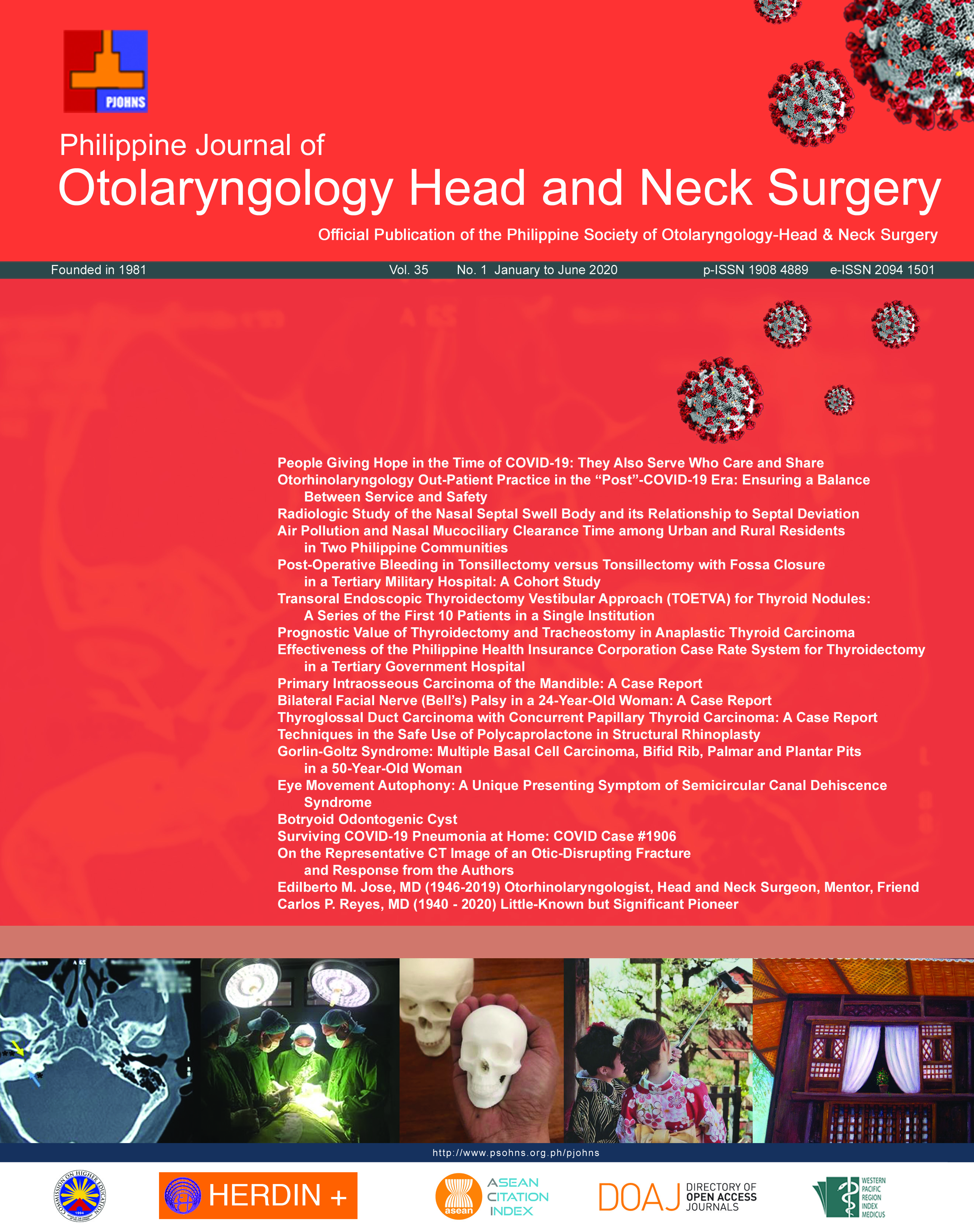Eye Movement Autophony: A Unique Presenting Symptom of Semicircular Canal Dehiscence Syndrome
DOI:
https://doi.org/10.32412/pjohns.v35i1.1301Keywords:
otolaryngologist, temporal bone, vertigoAbstract
A 31-year-old woman presented with the very unusual symptom of being able to hear the movement of her eyeballs in her left ear: “I can hear my eyeballs move!” She initially described hearing a recurrent “swishing” sound that would occur intermittently. She eventually realized that its occurrence coincided with eyeball movement. In the eight months’ duration of her symptom, she had been unable to obtain a diagnosis from physicians whom she consulted and had even been referred for psychiatric evaluation and treatment. An otolaryngologist whom she consulted had a standard pure tone audiometric examination done, and this showed normal hearing acuity in both ears. A Magnetic Resonance Imaging (MRI) of the inner ear and brain likewise showed no abnormalities. Due to the peculiarity of the patient’s complaint, the otolaryngologist consulted with a neurotologist who suspected the presence of a semicircular canal dehiscence. A computerized tomographic imaging study of the temporal bone confirmed the presence of a left superior semicircular canal dehiscence syndrome. (Figures 1 & 2)
First described by Minor et al. in 1998, superior semicircular canal dehiscence syndrome is a neurotologic condition that characteristically presents as vertigo, oscillopsia, and/or disequilibrium induced by sound or changes in middle ear or intracranial pressure.1 Subsequent clinical studies described the presence of audiologic symptoms, the most prominent of which were conductive hearing loss and autophony with or without vestibular manifestations.2 Patients described an increased sensitivity to internally generated bone-conducted sounds, such as the heartbeat, chewing, footsteps hitting the ground and eye movements. It is of particular interest that the ability to hear one’s own eye movements, a condition known as eye movement autophony, currently appears to have been described as a symptom only in patients with semicircular canal dehiscence syndrome.3 Anecdotally, although the author of this report has diagnosed quite a number of patients with semicircular canal dehiscence syndrome manifesting primarily with vestibular symptoms, this particular case is the only one that presented with eye movement autophony as the primary and only symptom.
Although the patient was not physically incapacitated by vertigo or chronic disequilibrium, she was significantly bothered by the unrelenting nature of her particular symptom. She subsequently underwent a transmastoid plugging of the superior semicircular canal which completely relieved her of the symptom.
Downloads
Published
How to Cite
Issue
Section
License
Copyright transfer (all authors; where the work is not protected by a copyright act e.g. US federal employment at the time of manuscript preparation, and there is no copyright of which ownership can be transferred, a separate statement is hereby submitted by each concerned author). In consideration of the action taken by the Philippine Journal of Otolaryngology Head and Neck Surgery in reviewing and editing this manuscript, I hereby assign, transfer and convey all rights, title and interest in the work, including copyright ownership, to the Philippine Society of Otolaryngology Head and Neck Surgery, Inc. (PSOHNS) in the event that this work is published by the PSOHNS. In making this assignment of ownership, I understand that all accepted manuscripts become the permanent property of the PSOHNS and may not be published elsewhere without written permission from the PSOHNS unless shared under the terms of a Creative Commons Attribution-NonCommercial-NoDerivatives 4.0 International (CC BY-NC-ND 4.0) license.



